|
News Archive: April 1-30 |

|
Saturn's subtle spectrum
Dreamy colors ranging from pale rose to butterscotch to sapphire give this utterly inhospitable gas planet a romantic appeal. Shadows of the rings caress the northern latitudes whose blue color is presumed to be a seasonal effect. The amazing image was taken by the Cassini orbiter.
 FULL STORY FULL STORY
 |  |

|
 |
Titan's northern hazes
The complex and dynamic atmosphere of Titan displays multiple haze layers near the north pole in this Cassini view, which also provides an excellent look at the detached stratospheric haze layer that surrounds the moon at lower latitudes.
 FULL STORY FULL STORY
 |  |

|
 |
Frontier worlds
The three very different moons seen here provide targets of great interest for planetary scientists studying the Saturn system. Captured here by Cassini, along with the rings, are Tethys at upper right, Enceladus below center and Janus at lower left.
 FULL STORY FULL STORY
 |  |

|
 |
Delta 2: Photo gallery of Friday's rocket launch
This collection of images shows the Boeing Delta 2 rocket launching from Vandenberg Air Force Base at 3:02 a.m. local time Friday with the CALIPSO and CloudSat atmospheric research satellites. Enjoy!
 IMAGES: ENTER THE GALLERY IMAGES: ENTER THE GALLERY
 |  |

|
 |

Additional coverage for subscribers:
 VIDEO:
THE FULL LAUNCH EXPERIENCE PLAY VIDEO:
THE FULL LAUNCH EXPERIENCE PLAY
 SUBSCRIBE NOW SUBSCRIBE NOW

|
NASA analysis of shuttle fuel tank enters final stages
NASA managers have decided not to make any major, last-minute changes to the foam insulation that prevents ice from forming around fittings that hold pressurization lines and a cable tray to the space shuttle Discovery's external fuel tank. Work to minimize the amount of foam used on the fittings will continue but in the near term, wind tunnel testing shows the so-called ice/frost ramps should stand up to the aerodynamic buffeting of launch as is, without shedding large, potentially dangerous pieces of insulation.
 FULL STORY FULL STORY
 |  |

|
 |

Additional coverage for subscribers:
 VIDEO:
FRIDAY'S SHUTTLE NEWS CONFERENCE DIAL-UP | BROADBAND VIDEO:
FRIDAY'S SHUTTLE NEWS CONFERENCE DIAL-UP | BROADBAND
 VIDEO:
EXTERNAL TANK MATED TO SOLID ROCKET BOOSTERS PLAY VIDEO:
EXTERNAL TANK MATED TO SOLID ROCKET BOOSTERS PLAY
 VIDEO:
PAYLOAD BAY DOORS CLOSED FOR HANGAR DEPARTURE PLAY VIDEO:
PAYLOAD BAY DOORS CLOSED FOR HANGAR DEPARTURE PLAY
 SUBSCRIBE NOW SUBSCRIBE NOW

|
7th shot the lucky one for Delta rocket launch
You could say it was a dream for insomniacs but a nightmare for everyone else. A week of night-owl countdowns to launch a Boeing Delta 2 rocket loaded with two atmospheric research satellites ended in scrubs for one reason or another. But try number seven proved to be the lucky one Friday morning, as the Delta rocket successfully blasted off from California.
 MISSION STATUS CENTER - live updates! MISSION STATUS CENTER - live updates!
 LAUNCH EVENTS TIMELINE LAUNCH EVENTS TIMELINE
 GROUND TRACK MAP GROUND TRACK MAP
 IMAGES: FIRST LAUNCH ATTEMPT IMAGES: FIRST LAUNCH ATTEMPT
 |  |

|
 |

Additional coverage for subscribers:
 VIDEO:
THE FULL LAUNCH EXPERIENCE PLAY VIDEO:
THE FULL LAUNCH EXPERIENCE PLAY
 VIDEO:
DELTA 2 ROCKET BLASTS OFF! PLAY VIDEO:
DELTA 2 ROCKET BLASTS OFF! PLAY
 VIDEO:
MOBILE SERVICE TOWER VIEW OF LIFTOFF PLAY VIDEO:
MOBILE SERVICE TOWER VIEW OF LIFTOFF PLAY
 VIDEO:
LAUNCH REPLAY FROM CAMERA ON BACK SIDE OF PAD PLAY VIDEO:
LAUNCH REPLAY FROM CAMERA ON BACK SIDE OF PAD PLAY
 VIDEO:
CALIPSO SUCCESSFULLY DEPLOYED FROM ROCKET PLAY VIDEO:
CALIPSO SUCCESSFULLY DEPLOYED FROM ROCKET PLAY
 VIDEO:
CLOUDSAT SUCCESSFULLY DEPLOYED FROM ROCKET PLAY VIDEO:
CLOUDSAT SUCCESSFULLY DEPLOYED FROM ROCKET PLAY
 VIDEO:
POST-LAUNCH INTERVIEW WITH NASA LAUNCH MANAGER PLAY VIDEO:
POST-LAUNCH INTERVIEW WITH NASA LAUNCH MANAGER PLAY

 VIDEO:
UPPER LEVEL WINDS SCRUB TUESDAY ATTEMPT PLAY VIDEO:
UPPER LEVEL WINDS SCRUB TUESDAY ATTEMPT PLAY
 VIDEO:
CLOSE-UP VIEWS OF FIRST STAGE ENGINE STEERING TEST PLAY VIDEO:
CLOSE-UP VIEWS OF FIRST STAGE ENGINE STEERING TEST PLAY
 VIDEO:
LAUNCH PAD TOWER ROLLED BACK MONDAY EVENING PLAY VIDEO:
LAUNCH PAD TOWER ROLLED BACK MONDAY EVENING PLAY
 VIDEO:
DELTA 2 ROCKET PRE-LAUNCH CAMPAIGN PLAY VIDEO:
DELTA 2 ROCKET PRE-LAUNCH CAMPAIGN PLAY
 VIDEO:
PRE-LAUNCH NEWS CONFERENCE DIAL-UP | BROADBAND VIDEO:
PRE-LAUNCH NEWS CONFERENCE DIAL-UP | BROADBAND
 VIDEO:
SCIENCE OF CALIPSO/CLOUDSAT DIAL-UP | BROADBAND VIDEO:
SCIENCE OF CALIPSO/CLOUDSAT DIAL-UP | BROADBAND
 SUBSCRIBE NOW SUBSCRIBE NOW

|
Hubble's spectacular view of a comet's breakup
The Hubble Space Telescope is providing astronomers with extraordinary views of comet 73P/Schwassmann-Wachmann 3, which is falling apart right before our eyes. Recent Hubble images have uncovered many more fragments than have been reported by ground-based observers. These observations provide an unprecedented opportunity to study the demise of a comet nucleus.
 FULL STORY FULL STORY
 |  |

|
 |
Digging into the secrets of fossil galaxy clusters
Taking advantage of the high sensitivity of ESA's XMM-Newton and the sharp vision of NASA's Chandra X-Ray space observatories, astronomers have studied the behaviour of massive fossil galaxy clusters, trying to find out how they find the time to form.
 FULL STORY FULL STORY
 |  |

|
 |
Galaxies don mask of stars in new Spitzer image
A pair of dancing galaxies appears dressed for a cosmic masquerade in a new image from NASA's Spitzer Space Telescope. The infrared picture shows what looks like two icy blue eyes staring through an elaborate, swirling red mask. These "eyes" are actually the cores of two merging galaxies, which recently met and began to twirl around each other.
 FULL STORY FULL STORY
 |  |

|
 |
Remote sensing spacecraft launched on Chinese rocket
China's first space launch of the year came Wednesday when a multipurpose remote sensing satellite was carried into orbit to begin a mission to aid scientific users and serve economic needs.
 FULL STORY FULL STORY
 |  |

|
 |
Pieces of NASA's next Mars mission are coming together
NASA's Phoenix Mars Lander, the next mission to the surface of Mars, is beginning a new phase in preparation for a launch in August 2007. As part of this "assembly, test and launch operations" phase, Phoenix team members are beginning to add complex subsystems such as the flight computer, power systems and science instruments to the main structure of the spacecraft.
 FULL STORY FULL STORY
 |  |

|
 |
Cargo ship docks to station
The International Space Station received its 21st supply ship Wednesday with the successful docking by a Russian Progress freighter at 1741 GMT (1:41 p.m. EDT). The vessel is carrying about 5,000 pounds of cargo, including 2,359 pounds of spare parts, repair equipment and science gear, 1,918 pounds of propellant for station thrusters, 661 pounds of water and 103 pounds of oxygen and air.
 LAUNCH STORY LAUNCH STORY
 |  |

|
 |

Additional coverage for subscribers:
 VIDEO:
PROGRESS SHIP RENDEZVOUS WITH THE STATION PLAY VIDEO:
PROGRESS SHIP RENDEZVOUS WITH THE STATION PLAY
 VIDEO:
FULL MOVIE OF FINAL APPROACH TO DOCKING PLAY VIDEO:
FULL MOVIE OF FINAL APPROACH TO DOCKING PLAY
 VIDEO:
DOCKING TO THE ZVEZDA SERVICE MODULE PLAY VIDEO:
DOCKING TO THE ZVEZDA SERVICE MODULE PLAY
 SUBSCRIBE NOW SUBSCRIBE NOW

|
Comet with a broken heart
On Sunday night, ESO's Very Large Telescope observed fragment B of the comet Schwassmann-Wachmann 3 that had split a few days earlier. To their great surprise, the ESO astronomers discovered that the piece just ejected by fragment B was splitting again! Five other mini-comets are also visible on the image. The comet seems thus doomed to disintegrate but the question remains in how much time.
 FULL STORY FULL STORY
 |  |

|
 |
OTHER HEADLINES Additional stories today
|
 |
New Israeli imaging spacecraft deployed in orbit -- A high resolution Israeli Earth observation satellite was delivered into orbit Tuesday on a mission to strengthen the nation's domestic imaging capability, which is heavily relied upon by Israel's national security officials. Reports say a priority for the new craft will be to spy on Iran's nuclear program and missile deployments.

Orbital to build satellite platform for AMC-21 satellite -- Orbital Sciences announced that it has signed a contract with Alcatel Alenia Space of France to supply a STAR-2 spacecraft bus and provide final spacecraft and system integration and test of SES AMERICOM's AMC-21 commercial communications satellite.
|
 |
Russian commission issues results of Proton review
The Russian State Commission has completed its investigation into the Proton M/Breeze M
failure that left the Arabsat 4A satellite in the wrong orbit eight weeks ago, during a mission for International Launch Services.
 ILS STATEMENT ILS STATEMENT
 |  |

|
 |
Old black holes rumble with roar of particle jets
Older supermassive black holes that were once thought to be quiet, actually generate high energy jets of particles powerful enough to put a brake on the formation of new stars, say a team of researchers.
 FULL STORY FULL STORY
 |  |

|
 |
Hidden structure of neutron star seen in starquake
Scientists using NASA's Rossi X-ray Timing Explorer have estimated the depth of the crust on a neutron star, the densest object known in the universe. The crust, they say, is close to a mile deep and so tightly packed that a teaspoon of this material would weigh about 10 million tons on Earth.
 FULL STORY FULL STORY
 |  |

|
 |
Happy sweet 16, Hubble
To celebrate the NASA-ESA Hubble Space Telescope's 16 years of success, the two space agencies are releasing this mosaic image of the magnificent starburst galaxy, Messier 82 (M82). It is the sharpest wide-angle view ever obtained of M82, a galaxy remarkable for its webs of shredded clouds and flame-like plumes of glowing hydrogen blasting out from its central regions.
 FULL STORY FULL STORY
 VIDEO COVERAGE VIDEO COVERAGE
 |  |

|
 |
International Space Station supply ship launched
A Russian Soyuz rocket successfully launched an unmanned cargo freighter Monday that will dock with the International Space Station on Wednesday. It is packed with about 5,000 pounds of supplies, fuel, water and science gear. This is the 21st Progress ship sent to the station.
 FULL STORY FULL STORY
 |  |

|
 |
Atlas 5: The complete launch photo gallery
We've assembled a five-page collection of images from Thursday's Lockheed Martin Atlas 5 rocket launch carrying the European ASTRA 1KR television broadcast satellite from Cape Canaveral. Some pictures we posted on launch day; others have been added this weekend. Enjoy!
 IMAGES: ENTER THE GALLERY IMAGES: ENTER THE GALLERY
 IMAGES: NEWEST PHOTOS IMAGES: NEWEST PHOTOS
 |  |

|
 |
Spitzer: Galaxies are born inside dark matter clumps
Try mixing caramel into vanilla ice cream -- you will always end up with globs and swirls of caramel. Scientists are finding that galaxies may distribute themselves in similar ways throughout the universe and in places where there is lots of so-called dark matter.
 FULL STORY FULL STORY
 |  |
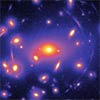
|
 |
OTHER HEADLINES Additional stories today
|
 |
One-of-a-kind meteorite unveiled -- The depths of space are much closer to home following the University of Alberta's acquisition of a meteorite that is the only one of its kind known to exist on Earth! What makes it so rare? The meteorite is 'pristine' - that is, still frozen and uncontaminated - and so provides an invaluable preserved record of material from when the solar system formed 4.57 billion years ago.
|
 |
Mars Express orbiter spots possible sites for life
By mapping minerals on the surface of Mars using the European Space Agency's Mars Express spacecraft, scientists have discovered the three ages of Martian geological history - as reported in the latest issue of Science - and found valuable clues as to where life might have developed.
 FULL STORY FULL STORY
 |  |

|
 |
Atlas 5 rocket launches TV broadcast craft for Europe
A Lockheed Martin Atlas 5 rocket kept its appointment to launch a television broadcast satellite that will serve million of homes across Europe, successfully roaring off a Florida launch pad Thursday on the exact minute scheduled months in advance.
 FULL STORY FULL STORY
 MISSION STATUS CENTER MISSION STATUS CENTER
 IMAGES: WEDNESDAY'S ROLLOUT TO THE PAD IMAGES: WEDNESDAY'S ROLLOUT TO THE PAD
 IMAGES: LAUNCH MORNING VIEWS OF ATLAS 5 IMAGES: LAUNCH MORNING VIEWS OF ATLAS 5
 IMAGES: LIFTOFF OF ASTRA 1KR! IMAGES: LIFTOFF OF ASTRA 1KR!
 IMAGES: MORE LAUNCH PHOTOS IMAGES: MORE LAUNCH PHOTOS
 |  |

|
 |

Additional coverage for subscribers:
 VIDEO:
ATLAS 5 BLASTS OFF WITH ASTRA 1KR PLAY | LONGER VERSION VIDEO:
ATLAS 5 BLASTS OFF WITH ASTRA 1KR PLAY | LONGER VERSION
 VIDEO:
LAUNCH AS SEEN FROM THE PRESS SITE PLAY VIDEO:
LAUNCH AS SEEN FROM THE PRESS SITE PLAY
 VIDEO:
ASTRA 1KR SUCCESSFULLY DEPLOYED FROM CENTAUR PLAY VIDEO:
ASTRA 1KR SUCCESSFULLY DEPLOYED FROM CENTAUR PLAY

 VIDEO:
WATCH THE PRE-LAUNCH NEWS CONFERENCE PLAY VIDEO:
WATCH THE PRE-LAUNCH NEWS CONFERENCE PLAY
 VIDEO:
TIME-LAPSE VIEW OF ATLAS 5 ROLLING TO THE PAD PLAY VIDEO:
TIME-LAPSE VIEW OF ATLAS 5 ROLLING TO THE PAD PLAY
 VIDEO:
ANIMATED PREVIEW OF ATLAS 5 LAUNCHING ASTRA 1KR PLAY VIDEO:
ANIMATED PREVIEW OF ATLAS 5 LAUNCHING ASTRA 1KR PLAY
 SUBSCRIBE NOW SUBSCRIBE NOW

|
Hubble spies gemstones in the southern sky
The Hubble Space Telescope has captured the most detailed images to date of the open star clusters in the Small Magellanic Cloud -- two sparkling sets of gemstones in the southern sky. These images show a myriad of stars in crystal clear detail.
 FULL STORY FULL STORY
 |  |

|
 |
Deadly cosmic event unlikely in our galaxy
Are you losing sleep at night because you're afraid that all life on Earth will suddenly be annihilated by a massive dose of gamma radiation from the cosmos? Some scientists have wondered whether a deadly astronomical event called a gamma ray burst could happen in a galaxy like ours.
 FULL STORY FULL STORY
 |  |

|
 |
Spacewalk strategy revised for next shuttle flight
Because of an over-loaded crew timeline and new heat-shield inspection requirements, shuttle flight planners have decided to eliminate one of three previously planned spacewalks from Discovery's upcoming mission - a spacewalk devoted to testing heat-shield repair techniques - in order to give the crew more time off in orbit, officials say. If the astronauts can conserve enough power, however, and if Discovery doesn't tarry on the launch pad, the mission will be extended one day and the spacewalk will be put back in the flight plan.
 FULL STORY FULL STORY
 |  |

|
 |
Unexpected detail in first Venus south pole images
The European Space Agency's Venus Express has returned the first-ever images of the hothouse planet's south pole, showing surprisingly clear structures and unexpected detail. The images were taken during the spacecraft's initial capture orbit after successful arrival last week.
 FULL STORY FULL STORY
 |  |

|
 |
Apollo lunar rocks suggest meteorite shower
New age measurements of lunar rocks returned by the Apollo space missions have revealed that a surprising number of the rocks show signs of melting about 3.9 billion years ago, suggesting that the moon - and its nearby neighbor Earth - were bombarded by a series of large meteorites at that time.
 FULL STORY FULL STORY
 |  |
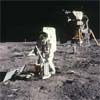
|
 |
Crescent Titan with rings
This poetic scene shows the giant, smog-enshrouded moon Titan behind Saturn's nearly edge-on rings. Much smaller Epimetheus (72 miles across) is just visible to the left of Titan (3,200 miles across).
 FULL STORY FULL STORY
 |  |

|
 |
Minotaur rocket hauls six satellites into space
Six tiny satellites sped into space Friday evening aboard an ultra-fast rocket booster, beginning a five-year mission to examine Earth's atmosphere and the underlying hints of climate change by employing a novel technique.
 MISSION STATUS CENTER MISSION STATUS CENTER
 IMAGES: PRE-LAUNCH VIEWS OF THE PAD IMAGES: PRE-LAUNCH VIEWS OF THE PAD
 IMAGES: MINOTAUR BLASTS OFF IN THICK FOG IMAGES: MINOTAUR BLASTS OFF IN THICK FOG
 |  |

|
 |
Tank foam lost during shuttle wind tunnel test
During wind tunnel tests earlier this week, NASA subjected a full-scale mockup of a shuttle external tank section to aerodynamic forces greater than a real tank would experience during launch. In one series of tests, unmodified foam insulation used to prevent ice buildups around external fittings suffered only minor damage while a redesigned "ice/frost ramp" suffered major foam loss.
 FULL STORY FULL STORY
 UPDATED FLIGHT PLAN UPDATED FLIGHT PLAN
 MISSION QUICK-LOOK: Page 1 | Page 2 MISSION QUICK-LOOK: Page 1 | Page 2
 |  |

|
 |
Mars cameras debut as NASA craft adjusts orbit
Researchers have released the first Mars images from two of the three science cameras on NASA's Mars Reconnaissance Orbiter. The test images were taken from nearly 10 times as far from the planet as the spacecraft will be once it finishes reshaping its orbit.
 FULL STORY FULL STORY
 |  |

|
 |
Mars rovers head for new sites after studying layers
NASA's Mars rover Spirit has reached a safe site for the Martian winter, while its twin, Opportunity, is making fast progress toward a destination of its own. The two rovers recently set out on important -- but very different -- drives after earlier weeks inspecting sites with layers of Mars history.
 FULL STORY FULL STORY
 |  |

|
 |
Rocket roars into space with Japanese satellite
A Japanese communications satellite to serve Southeast Asia and Hawaii took a sea-launched route to space Wednesday, blasting off aboard a 20-story rocket from a platform floating in the Pacific Ocean.
 FULL STORY FULL STORY
 MISSION STATUS CENTER MISSION STATUS CENTER
 |  |

|
 |
Hubble corrects size of solar system's tenth planet
NASA's Hubble Space Telescope has resolved the "tenth planet," nicknamed "Xena" for the first time, and has found that it is only just a little larger than Pluto. Previous ground-based observations suggested that Xena was about 30 percent greater in diameter than Pluto.
 FULL STORY FULL STORY
 |  |

|
 |
Shuttle turns 25
A video retrospective
Wednesday marks the 25th anniversary of the first space shuttle launch. Commander John Young and pilot Bob Crippen strapped aboard Columbia for a risky test-flight in space, lifting off at 7 a.m. from Kennedy Space Center. We've put together a video retrospective of STS-1.
 FULL COVERAGE FULL COVERAGE
 CREW POST-FLIGHT FILMS CREW POST-FLIGHT FILMS
 |  |

|
 |
NASA joins Ocean Surface Topography Mission
NASA has signed an agreement with other U.S. and international agencies to launch the Ocean Surface Topography Mission in 2008. The satellite, named Jason-2, will increase our understanding of ocean
circulation and improve climate forecasts and measurements of global sea-level change.
 FULL STORY FULL STORY
 |  |
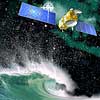
|
 |
A Venusian arrival:
Probe safely enters orbit
Venus received a visitor from its sister planet Tuesday morning when a European space probe completed a five-month interplanetary cruise and swooped into orbit to begin the first comprehensive scientific survey of its sultry atmosphere.
 FULL STORY FULL STORY
 LAUNCH COVERAGE LAUNCH COVERAGE
 |  |

|
 |
NASA to send impactor into moon in search of water
NASA has unveiled the Lunar Crater Observation and Sensing Satellite, or LCROSS, that will launch piggyback with the Lunar Reconnaissance Orbiter spacecraft in October 2008. LCROSS will use the launch vehicle's spent upper stage to crash into the moon's south pole in an explosive search for water.
 FULL STORY FULL STORY
 |  |

|
 |

Additional coverage for subscribers:
 VIDEO:
BRIEFING ON THE NEW LUNAR MISSION DIAL-UP | BROADBAND VIDEO:
BRIEFING ON THE NEW LUNAR MISSION DIAL-UP | BROADBAND
 VIDEO:
MISSION MANAGER NARRATES LCROSS ANIMATION PLAY VIDEO:
MISSION MANAGER NARRATES LCROSS ANIMATION PLAY
 SUBSCRIBE NOW SUBSCRIBE NOW

|
Survey finds galaxy cluster building-block process
A study of the Universe's most massive galaxy clusters has shown that mergers play a vital role in their evolution. Astronomers used a combination of data from telescopes located in Hawaii and Chile and the Hubble Space Telescope to study populations of stars in the Universe's most massive galaxy clusters over a range of epochs - the earliest being half the age of the Universe.
 FULL STORY FULL STORY
 |  |

|
 |
Search for dark galaxies
First results from the Arecibo Galaxy Environment Survey (AGES) suggest the discovery of a new dark galaxy. The AGES survey, which started in January, is the most sensitive, large-scale survey of neutral hydrogen to date. Neutral hydrogen is a key tool in the search for dark galaxies as it can be detected even when there are no stars or other radiation sources to "shine a light" on matter.
 FULL STORY FULL STORY
 |  |

|
 |
Exploding star within a star
Amateur astronomers reported in February that a faint star in the constellation of Ophiuchus had suddenly become clearly visible in the night sky without the aid of a telescope. Records show that this so-called recurrent nova, has previously reached this level of brightness five times in the last 108 years. The latest explosion has been observed in unprecedented detail by an armada of space and ground-based telescopes.
 FULL STORY FULL STORY
 |  |

|
 |
Space station crew returns to Earth aboard Soyuz
The Soyuz capsule carrying Expedition 12 commander Bill McArthur, flight engineer Valery Tokarev and Brazilian Space Agency astronaut Marcos Pontes returned to Earth on Saturday, touching down in north-central Kazakhstan at 2348 GMT (7:48 p.m. EDT).
 FULL STORY FULL STORY
 MISSION STATUS CENTER MISSION STATUS CENTER
 |  |
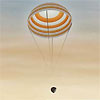
|
 |

Additional coverage for subscribers:
 VIDEO:
THE SOYUZ CAPSULE UNDOCKS FROM STATION PLAY VIDEO:
THE SOYUZ CAPSULE UNDOCKS FROM STATION PLAY
 VIDEO:
DEPARTING CREW BOARDS THEIR SOYUZ CAPSULE PLAY VIDEO:
DEPARTING CREW BOARDS THEIR SOYUZ CAPSULE PLAY
 VIDEO:
CREWS HOLD CHANGE OF COMMAND CEREMONY PLAY VIDEO:
CREWS HOLD CHANGE OF COMMAND CEREMONY PLAY
 SUBSCRIBE NOW SUBSCRIBE NOW

|
Searching through rubble of supernova remnants
A study of supernova remnants - material blown out into space during death throes of giant stars - has shown that a bubble of gas enveloping our Solar System is being shoved backwards by the debris of another, more recent, supernova.
 FULL STORY FULL STORY
 |  |

|
 |
Two supermassive black holes spirling to collision
A pair of supermassive black holes in the distant universe are intertwined and spiraling toward a merger that will create a single super-supermassive black hole capable of swallowing billions of stars, according to a new study by astronomers.
 FULL STORY FULL STORY
 |  |

|
 |
Uranus' newly found moon embedded in a blue ring
The outermost ring of Uranus, discovered just last year, is bright blue, making it only the second known blue ring in the solar system, according to a report this week in the journal Science. Perhaps not coincidentally, both blue rings are associated with small moons.
 FULL STORY FULL STORY
 |  |

|
 |
Cassini changes earlier belief about Saturn A-ring
Views of Saturn's stunning ring system from above by the Cassini-Huygens spacecraft now orbiting the planet indicate the prominent A ring contains more debris than once thought, according to a new University of Colorado at Boulder study.
 FULL STORY FULL STORY
 |  |

|
 |
Spitzer finds hints of planet birth around dead star
NASA's Spitzer Space Telescope has uncovered new evidence that planets might rise up out of a dead star's ashes. The infrared observatory surveyed the scene around a pulsar, the remnant of an exploded star, and found a surrounding disk made up of debris shot out during the star's death throes. The dusty rubble in this disk might ultimately stick together to form planets.
 FULL STORY FULL STORY
 |  |

|
 |
Mercury's formation impact splattered Earth
New computer simulations of Mercury's formation show the fate of material blasted out into space when a large proto-planet collided with a giant asteroid 4.5 billion years ago. The simulations, which track the material over several million years, shed light on why Mercury is denser than expected and show that some of the ejected material would have found its way to the Earth and Venus.
 FULL STORY FULL STORY
 |  |

|
 |
Solar wind whips up auroral storms on Jupiter, Saturn
Studies of Jupiter's auroras by scientists from the University of Leicester have challenged current theories about the processes controlling the biggest light-shows in the Solar System.
 FULL STORY FULL STORY
 |  |

|
 |
Hubble's stunning view of nearby dust clouds
The yearly ritual of spring cleaning clears a house of dust as well as dust "bunnies," those pesky dust balls that frolic under beds and behind furniture. NASA's Hubble Space Telescope has photographed similar dense knots of dust and gas in our Milky Way Galaxy. This cosmic dust, however, is not a nuisance. It is a concentration of elements that are responsible for the formation of stars in our galaxy and throughout the universe.
 FULL STORY FULL STORY
 |  |

|
 |
Swift observes an unusual bang in the far universe
Almost 40 years have passed since top secret nuclear weapon warning satellites accidentally discovered bursts of high energy gamma rays coming from space. Although many thousands of gamma ray bursts have since been detected, the origin and nature of these bursts is still not well understood.
 FULL STORY FULL STORY
 |  |
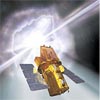
|
 |
Prometheus' pull on particles in Saturn F-ring
The rings around all the giant planets in our Solar System are thought to be stabilised by small "shepherd moons" that orbit in or near the rings and stabilize them by gravitational influences. The narrow F ring of Saturn - which lies just outside the spectacular main
rings - is tended by two small shepherds.
 FULL STORY FULL STORY
 |  |
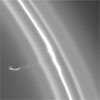
|
 |
OTHER HEADLINES Additional stories today
|
 |
NASA and ZERO-G agree on regular shuttle runway use -- NASA and Zero Gravity Corp. of Fort Lauderdale announced Tuesday the company will begin to regularly use the space shuttle's runway and landing facility at NASA's Kennedy Space Center, Fla. This agreement is the result of a successful pilot program to expand runway access for non-NASA activities.

Orbital Express passes major test milestones -- The Boeing Orbital Express system, a Defense Advanced Research Projects Agency (DARPA) program aimed at demonstrating fully autonomous on-orbit satellite servicing, last month completed two major test milestones. The program completed its Baseline Integrated System Test (BIST) of the Autonomous Space Transport Robotic Operations (ASTRO) spacecraft and a series of electromagnetic interference and compatibility tests to verify component operation in the spacecraft's actual electromagnetic environment.
|
 |
Massive amounts of water released by comet hit
A team of UK and US scientists used NASA's Swift satellite to observe the collision of NASA's Deep Impact spacecraft with comet Tempel 1. They are reporting Tuesday that the Swift observations show that the comet grew brighter and brighter in X-ray light after the impact and the total mass of water released by the impact was 250,000 tonnes.
 FULL STORY FULL STORY
 |  |

|
 |
Spying a cloud of alcohol spanning 288 billion miles
Astronomers based at Jodrell Bank Observatory have discovered a giant bridge of methyl alcohol, spanning approximately 288 billion miles, wrapped around a stellar nursery. The gas cloud could help our understanding of how the most massive stars in our galaxy are formed.
 FULL STORY FULL STORY
 |  |

|
 |
XMM-Newton survey shows secrets of the X-ray sky
The European Space Agency's XMM-Newton X-ray observatory has already been a spectacular success in many areas of astronomy - detecting distant clusters of galaxies, the faint afterglow of enigmatic gamma ray bursts and the effects of the collision of the Deep Impact probe with comet Tempel 1.
 FULL STORY FULL STORY
 |  |

|
 |
Space station crew set for overnight 'camp out'
The incoming and outgoing crews of the international space station have settled in for a week of hand-over work, along with an overnight "camp out" test aimed at making preparations for future spacewalks more efficient. Brazil's first astronaut, Marcos Pontes, appeared relaxed and all smiles at a news conference Monday, saying he's made good progress with a full slate of his own experiments and Earth observation photography.
 FULL STORY FULL STORY
 |  |

|
 |

Additional coverage for subscribers:
 VIDEO:
WATCH MONDAY'S NEWS CONFERENCE DIAL-UP | BROADBAND VIDEO:
WATCH MONDAY'S NEWS CONFERENCE DIAL-UP | BROADBAND
 SUBSCRIBE NOW SUBSCRIBE NOW

|
A cosmic mystery unraveled
Scientists from The University of Exeter and the International University, Bremen have discovered what is thought to be the strongest magnetic field in the Universe. They show that violent collisions between neutron stars in the outer reaches of space create this field, which is 1000 million million times larger than our earth's own magnetic field.
 FULL STORY FULL STORY
 |  |
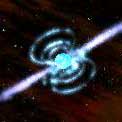
|
 |
OTHER HEADLINES Additional stories today
|
 |
Ball Aerospace wins Space Test satellite contract -- Ball Aerospace & Technologies Corp. has been selected as the prime contractor by the United States Air Force Space and Missile Systems Center for the Space Test Program's Standard Interface Vehicle (STP-SIV).

SpaceDev picked by Air Force for sophisticated nanosatellite -- SpaceDev has been awarded a $1.25 million contract from the Air Force Research Laboratory Space Vehicles Directorate, for the preliminary design of a nanosatellite capable of independently providing localized Space Situational Awareness of the local space environment of a host satellite.

Lockheed to design Mars Science Lab's aeroshell -- Lockheed Martin has been awarded a preliminary design and concept study start-up contract by NASA's Jet Propulsion Laboratory for the Mars Science Laboratory aeroshell system. The MSL heatshield will be the largest ever built at about 15 feet in diameter. For comparison, the heatshields of the Mars Exploration Rovers measured 8.5 feet and Apollo capsule heatshields measured 12.8 feet.
|
 |
Probes witness facet of Earth's magnetic behavior
Five spacecraft from two European Space Agency missions unexpectedly found themselves engulfed by waves of electrical and magnetic energy as they travelled through Earth's night-time shadow, a new report says. The data collected by the spacecraft are giving scientists an important clue to the effects of 'space weather' on Earth's magnetic field.
 FULL STORY FULL STORY
 |  |
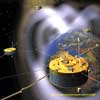
|
 |
|
Read our earlier news archive page.
|



